Learn how to make sauerkraut with this easy recipe including step-by-step photos and video to guide you along. This is a quick sauerkraut recipe with the fermented cabbage ready in just 7 days. Great for keeping your gut health in tip-top shape, sauerkraut can be added as a healthy condiment to any meal. It’s vegan, vegetarian, gluten-free, low-carb friendly.
In This Post:
- ℹ️ Why Make Sauerkraut
- 📷 📹 How To Make
- ⏰ How Long To Ferment It
- 💡 Variations
- 🍽 How To Eat Sauerkraut
- 📝 Go To Full Recipe
- 🙋♀️ Sauerkraut FAQs
Why Make Your Own Sauerkraut
Gut health is one of the most talked-about topics amongst nutrition and wellness experts and enthusiasts. Many studies are now showing that healthy, well-balanced gut flora is one of the key factors in achieving good digestion and health in general.
As well as avoiding stress and toxins that cause an imbalance of good and bad bacteria in our gut in the first place, it’s important to include a variety of fermented foods and probiotics in your diet. Read about the top 10 foods for a healthy gut here.
Freshly fermented cabbage, also known as sauerkraut, is a wonderful and simple way to add some friendly bacteria to your gut. It’s not always easy to find fresh sauerkraut in stores (or it’s super expensive) and people often buy the pasteurised kind you find in the non-refrigerated sections of the supermarket.
However, that’s not the sauerkraut you want as all that lively bacteria are destroyed during the pasteurisation process. What you want is fresh sauerkraut in which the bacteria are alive and thriving and which you would keep refrigerated.
This easy sauerkraut recipe will teach you how to make your own in just 30 minutes plus 7 days of fermentation. And, it costs a fraction of store-bought sauerkraut. Winning!
You can also check out my fermented beets and cauliflower here.
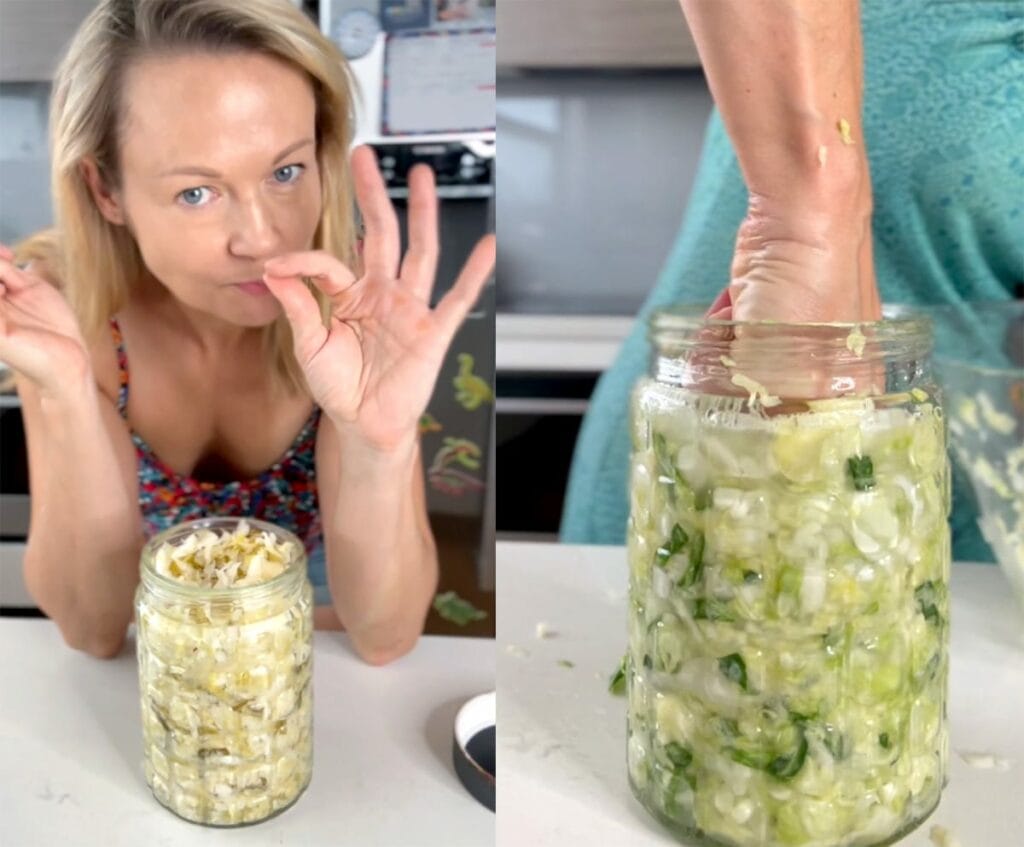
How To Make Sauerkraut
Below, I show how to make sauerkraut in your kitchen. For a small batch of fermented kraut, all you need is a head of cabbage, salt and a jar! You can use white or red cabbage for this recipe. You can watch the video first and then follow more detailed steps and notes below.
Step 1 – Preparing The Cabbage, Salt & Jar
- I often use a medium head of cabbage (just under 1 kg or around 2 lbs ). This is suitable for a smaller batch of sauerkraut. Remove the outer leaves that might be dirty and cut the cabbage into quarters. I recommend weighing the cabbage at this point to see how much salt you will need.
- How much salt do you need to make sauerkraut? I use kosher salt as it measures more accurately and spreads more evenly. You need about 2.25-2.5% of salt to the weight of the cabbage. So, for 900 grams or 2 pounds of cabbage, you need about 20 grams of salt or 4 teaspoons).
- Shred the cabbage into thin strips, removing the core. You can use a food processor for this.
- Transfer half of the cabbage to a very large bowl or container. Sprinkle with half of the salt. Add the remaining cabbage and the remaining salt on top.
- Toss through and leave for about 15 minutes for the cabbage to start releasing its juices (the salt draws them out).
- Preparing the jar: In the meantime, wash a medium glass jar (about 750 ml to 1 litre if using medium to large head of cabbage) and its lid with soapy water, rinse with hot water and let it dry on a towel. There is no need to sterilise it any further than that.
- How do you know what size jar to use? Cabbage will shrink once squeezed and stuffed into a jar, so oftentimes people find that their selected jar is too large. I find that around 1 kg of cabbage needs a jar that’s around 750 grams to 1 litre. If you find yourself with a jar that’s too large for the amount of cabbage, you will need to top any remaining space in that jar with salted water. It should be as salty as the sea. Alternatively, use two small jars.
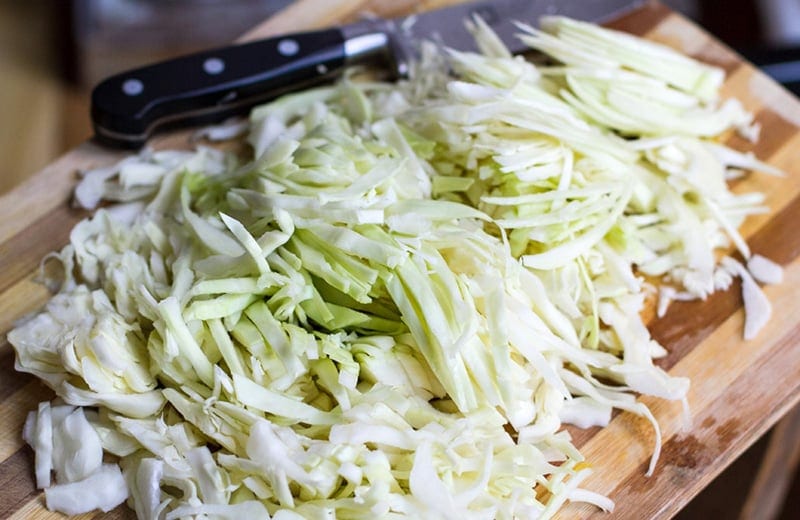
Step 2 – Squeezing The Cabbage To Produce Brine
Add about a third cup of filtered water and toss through the cabbage. Start squeezing and mixing the cabbage with your hands. Squeeze hard to get as much juice out of the cabbage as possible and after a few minutes, it will become lightly bruised and softened, with a decent amount of salty brine.
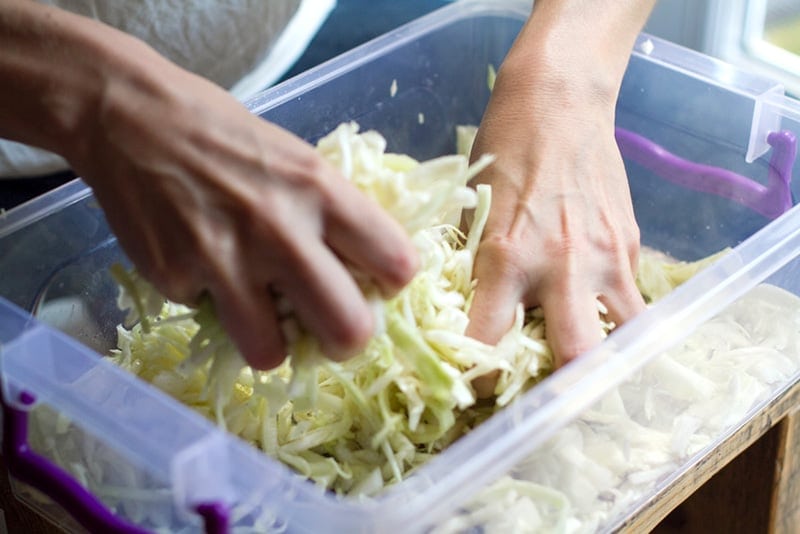
Step 3 – Stuffing The Cabbage Into A Clean Jar
- Start packing the jar we prepared earlier with the cabbage. Press the cabbage down with your fingers and then also with a spoon or a wooden stick. As you get closer to the top, use your fingers to really compact the cabbage in the jar, allowing the brine to float to the top.
- The idea is to eliminate as many air bubbles inside the jar as possible. You want to leave about a centimetre of space at the top for the liquid.
- Finally, pour in the remaining brine/juice to cover the cabbage completely as that will protect it from oxygen and external bacteria.
- Any little bits of cabbage floating on top are okay, they can be discarded after a few days.
- If you have leftover cabbage, you can pan fry it with some onions for a yummy side dish.
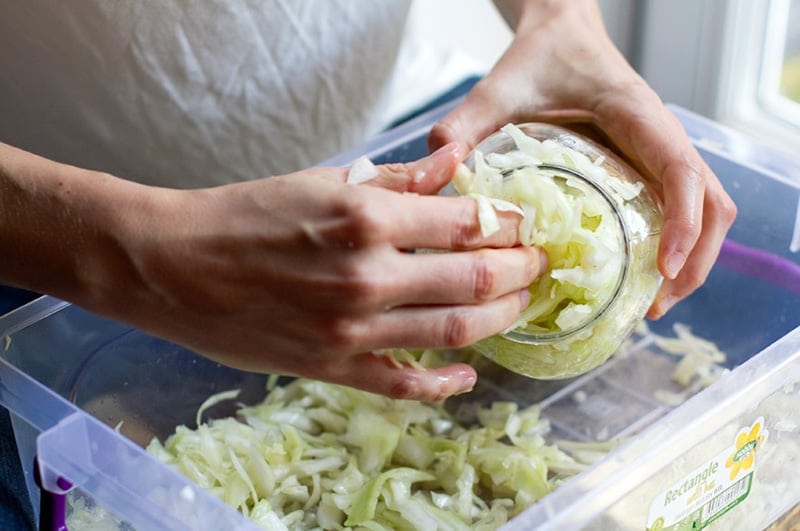
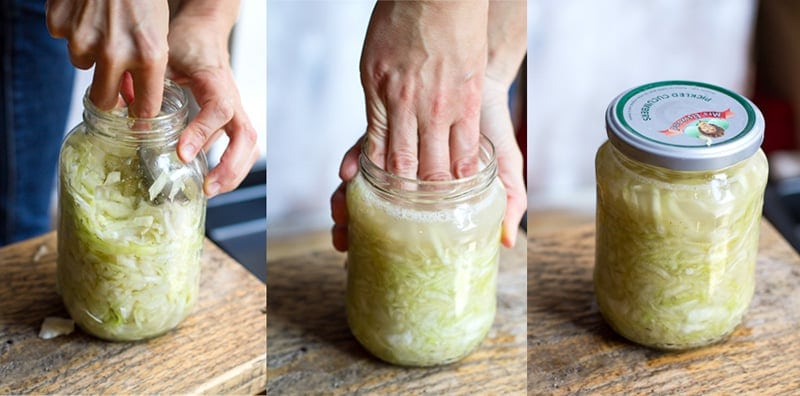
Step 4 – Sauerkraut Fermentation Stages
Cover the jar with a lid and set it aside somewhere warm, say near a stove. The fermentation process can take anywhere from 5 to 7 days (and even longer), depending on how warm or cold the air in the room is.
I recommend that you ferment the sauerkraut for about 7 days and that’s how I like it as it’s tangy but not too sour while still retaining its crunch. The longer you leave the jar out of the fridge, the sourer and softer the cabbage will become.
Now, there are a couple of things you need to do while the cabbage is fermenting. After about 24 hours, the pressure in the jar will build up as the bubbles will form during the fermentation. It’s important to gently open the lid and let some of that air/pressure out – this is called ‘burping the jar’ – and also to check that the cabbage is still covered with liquid.
Press it down with your fingers to let the juices float back to the top or add a little more water and a sprinkle of salt. I recommend the following frequency for releasing the air pressure and checking the liquid is covering the cabbage:
- 24 hours later – 1st release
- 36 hours later – 2nd release (12 hours after the first release)
- 48 hours later – 3rd release (12 hours after the second release)
- 72 hours later – just check the liquid, the pressure should no longer be building up (24 hours after the third release)
How Long To Ferment Sauerkraut
- The speed of fermentation will depend on how warm or cold the environment is. For example, in the summer months in Australia, my sauerkraut is often ready after 7 days and in winter, I might leave it out for 10 days. When we lived in Ukraine, we often had jars of sauerkraut in our cold basement for months through the winter.
- I like my sauerkraut after 7 days of fermenting outside of the refrigerator because it’s not too sour and still has a lovely crunch. I then move the jar to the fridge and start enjoying it daily. The sauerkraut will keep fermenting in the fridge but at a MUCH slower rate and it will keep for a few months.
- You can keep fermenting the sauerkraut outside of the fridge for many more weeks. It will get a little more sour and much softer in texture.
Sauerkraut Variations
- This is a very basic sauerkraut recipe that you can apply to other vegetables. You can add grated carrot or other crunchy vegetables to the cabbage, some garlic, coriander seeds, dill, mustard seeds and other spices to make different variations of this sauerkraut.
- Add Korean chili paste, garlic, ginger and green onions to make a variation of kimchi.
- Add cumin seeds, garlic, fresh coriander/cilantro and chili to make a Tex Mex sauerkraut.
How To Eat Sauerkraut
- I like to add a little sauerkraut to my eggs in the morning or as a side with our dinner or lunch meal but I usually only have it once a day. It’s also great in sandwiches and wraps.
- You can drizzle it with a little olive oil and add some spring onion for sharpness and to freshen it up. I love it this way!
- Please note, all the gut-health benefits are in the uncooked sauerkraut! Once you heat it past a certain temperature, that good bacteria will die so eat it fresh.
- Having said that, you can cook the sauerkraut and it’s great with smoked pork ribs and sliced grilled kielbasa. Sauerkraut sauetted with some onions is a delicious stuffing for dumplings!

More Homemade Condiments
- 10 Dairy-Free Yoghurts To Make At Home
- Yoghurt Ranch Dressing With Garlic & Herbs
- Homemade Paleo Mayonnaise
- 15+ Sugar-Free Salad Dressings
- Basil Cashew Pesto
Want to Save This Recipe?
Enter your email & I’ll send it to your inbox. Plus, get great new recipes from me every week!
By submitting this form, you consent to receive emails from Cooked & Loved
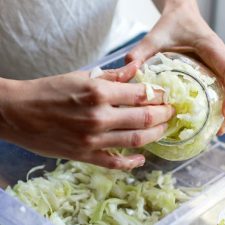
Equipment
- 1 clean jar 750ml to 1 litre
- 1 large mixing bowl or plastic container
Ingredients
- 1 medium head white cabbage about 900 g / 2 lbs.
- 4 teaspoons sea salt about 20 grams
- ⅓ cup filtered water
Instructions
- Cut the cabbage into quarters, remove the core and shred with a knife or a food processor.
- Add to a bow and sprinkle with salt, toss through and set aside for 15 mins to release some of the cabbage juice.
- Wash the glass jar and its lid in soapy water, rinse and dry. No need to sterilise.
- Add 1/3 cup of water to the cabbage and start mixing and squeezing everything with your hands for a few minutes to bruise the vegetable and release the juices.
- Pack the cabbage tightly into the clean jar. Use a spoon or a wooden stick to push down the cabbage so it’s very compacted and the brine floats tot he top. Fill up to the top, leaving about 1-2cm space at the top. Press down again so that the cabbage is covered by the juice, pour in the rest of the brine. Cover tightly with the lid and set aside in a warm spot, like near the stove.
- Leave the jar out at this room temperature for at least 7 days. For the first few days, open the lid every 12-16 hours to let some of the pressure out and to make sure the cabbage is submerged under the liquid. Add a little extra salted water if needed.
- Taste after 7 days and it should be fermented enough to start consuming. Ferment longer for more sour and softer kraut. After that, keep the jar in the fridge for a few weeks.
Notes
Nutrition
Sauerkraut FAQs
Q. How long will sauerkraut last in the fridge after opening the jar to eat it?
A couple of months. It will dry up a little bit so I recommend adding a little bit of salted water after a few weeks.
Q. I’m wanting to make a big excess of sauerkraut juice to take shots could I double the water and salt and make a larger layer of brine?
Yes, that would be the way to do it. Use a slightly larger jar than the amount of cabbage. Make extra salty brine (the water should taste like sea water, fairly salty) and make sure to cover the cabbage with extra brine to the top of the jar.
Q. I used one small head of cabbage, not knowing how much it would shrink. So, my jar is only half full. Even though I’ve pressed it down as hard as I can, little bits keep floating up above the liquid level. Is this ok? Should I add more water?
This can often happen as the cabbage shrinks once it’s been squeezed and stuffed into the jar. I recommend having a couple of jars in different sizes. Say 500 ml and 750 ml, I keep any leftover jars from pasta sauces and so on. If you find yourself with a jar that’s too large for the amount of cabbage, you will need to top any remaining space in that jar with salted water. It should be as salty as the sea. Alternatively, use two small jars. Any little bits of cabbage floating on top are okay, they can always be discarded after a few days.
Do you ferment at home? What are your favourite foods and combinations? Share this post with your friends and family and get them into fermenting!
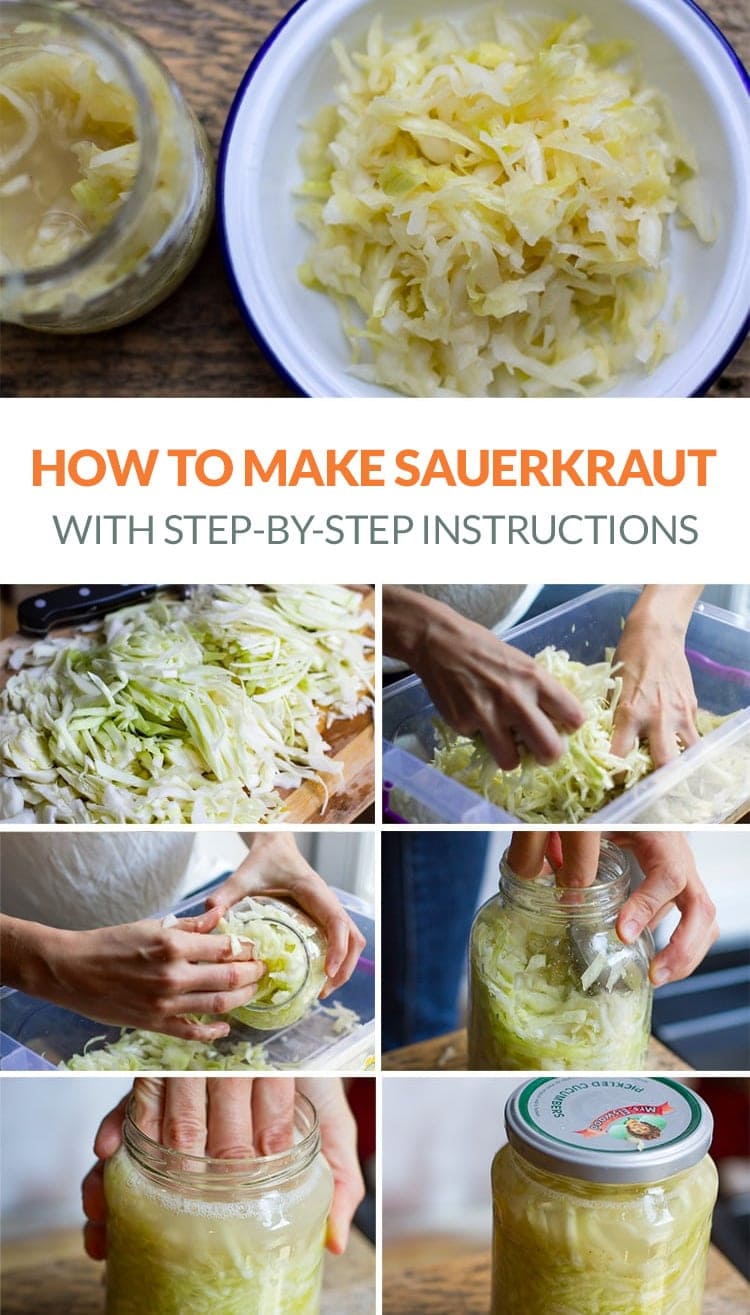

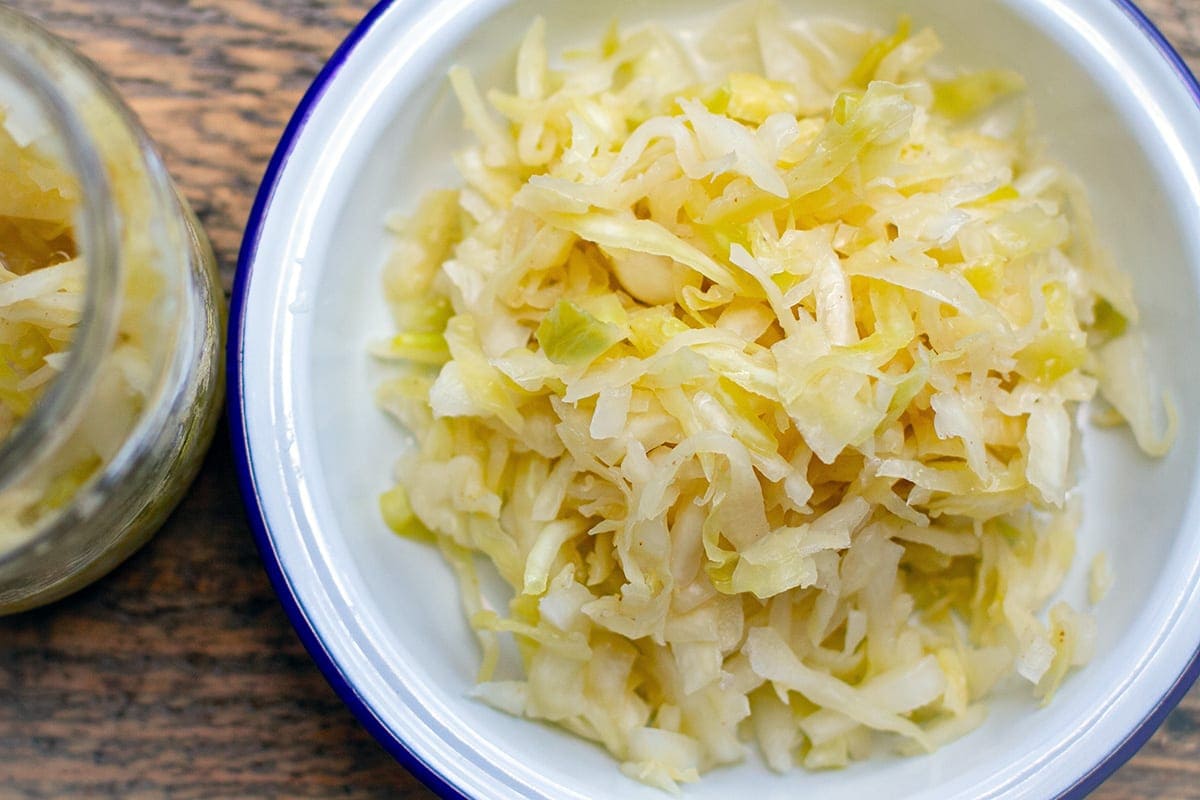




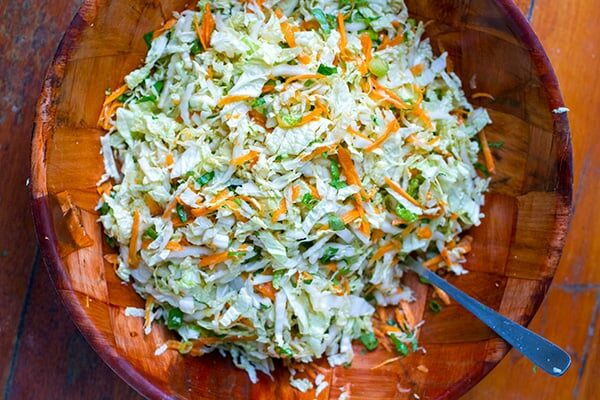
I love Sauerkraut and this looks like a really simple recipe. Thanks for sharing 🙂
I really love sauerkraut and this looks like a simple recipe. Thanks for sharing 🙂
I never do that afraid not be ok but I just order a fermenter from amazon and will try to do it. I eat that so long time ago and love it so I hope will be ok to do it
I love my fermenter for kombucha too! Soo good! Keeps my gut working properly! And cheap to make and easy!
Thank you so much for the great instructions! I’ve been wanting to try making sauerkraut, and these steps were very clear and easy to follow.
I have a question: I used one small head of cabbage, not knowing how much it would shrink. So, my jar is only half full. Even though I’ve pressed it down as hard as I can, little bits keep floating up above the liquid level. Is this ok? Should I add more water?
Hey Alisa, this is ok. Ideally you don’t want to have so much space for liquid. I would instead use a smaller jar, if you have one. But it’s ok if some bits float to the top, as long as most of the cabbage is submerged under liquid and thus not exposed to any oxygen.
I like to use the outermost, skanky leaves from Step 1, left whole, folded up and pushed under the shoulders of the jar to plug the opening, keeping the shredded cabbage submerged. When using napa cabbage or bok choy, I plug the jar with the stem cluster. If any of my kraut gets moldy, it’ll be that one leaf or the root end and they’re a snap to remove without spreading mold throughout the rest of the batch.
I had the same problem with the jar not being full. I tried to plug the top with some of the outer leaves as someone suggested, and then I topped up with water so that everything was submerged. Does that work?
Hi. So I don’t need to pressure cook the jar when I’m done? You just put the lid on like normal? Thanks!
Yes, I just make sure the cabbage is completely covered with brine/salted water and pop the lid on top. You should only have about 1cm of empty space under the lid left for some pressure to build up.
Hi there,
Thanks for sharing! I just prepared this. Now the wait game. I had a bit of space about an inch of space left over after pouring the brine. All the cabbage is covered. Hope it turns out!
I have questions. Do you tight the lid or leave it ajar ? I read on many fermentation sites that the lid supposed to be loose to allow gases to escape . Unless you use a Fido jar appropriate for fermentation. I also read that if the purpose of making sauerkraut is to get probiotics, the cabbage needs to ferment for at least 6 months .
Hey Miri,
The lid should be tight as letting in the oxygen continuously will potentially spoil the cabbage (not in the good way). The reason I instruct you to open the jar lid slightly every 24 or so hours at the start of the fermentation process, is to allow some of the gases to escape, but you then close the lid tightly again and make sure the cabbage is completely submerged under liquid, so it gets no oxygen. Cabbage can be fermented from anywhere between 5 days and 3 months. It doesn’t need to ferment for 6 months to develop probiotics, that stats to happen after 3 days, if not earlier. You might get more probiotics after a week or two weeks, but the fermentation time will also affect the texture and flavour of the sauerkraut: the longer you ferment it, the softer it will get, so it really depends on how you personally like it. You will get plenty of benefits from a 7-day ferment, so there is no need to wait for 6 months…not sure who’s said that, but that’s not accurate. I hope that helps 🙂
I keep mine tight because I check for built-up gas/bubbles every 24 hours or so for the first few days. Then the built up stops. If you plan to be away from the cabbage at the beginning of fermentation, you can keep it a little ajar. In regards to the probiotics, the good bacteria will start to form within a few days, that’s where that lactic acid comes from, so perhaps you get more of it after longer period of time but the sauerkraut will get much softer, so it depends on your taste preference.
The in-depth step by step directions with pictures are absolutely invaluable! Thank you so much for being such a helpful guide for me once I decide to jump into the deep end on making sauerkraut. I have been doing a ton of research before making the plunge so I don’t make any mistakes! Can’t wait to try this recipe! Thank you!
Once the sour kraut is fermented to your preference, can you then can it, either with water bath or pressure canner? How do you keep it for an extended period of time?
I don’t can it as it kind of kills all that beneficial bacteria, but once it’s fermented, I simply store in the fridge for up 2 months. Although it never lasts that long 😉
How long is it good for in the fridge and how do I know when it’s gone bad?
Hey Keira, I’ve kept my sauerkraut for 5-6 weeks in the fridge (not that it lasts so long). It sort of keeps fermenting even in the fridge, although very very slowly as it’s cold. It has never gone bad on me but you would look out for any foul smell or obvious growth of mold or discolouration.
This was my first attempt at fermentation of cabbage. My family loves sauerkraut. This recipe couldn’t be easier and tastes delicious.
Thanks Pam 🙂 Glad you found it easy and enjoyable.
Can u use hard plastic jar
For storing, I would stay away from plastic. For making the sauerkraut, you can do in a plastic container.
This is a great recipe. Why do I say that? Because it’s nearly identical to the recipe I’ve been using for years. The only difference is that I don’t mess with small amounts; I make six pounds of kraut at a time in a one-gallon glass jar. Also, for those of you using USA measurements, the salt to cabbage ratio is two tsp. of salt to one pound of cabbage.
When I open the jar to release pressure it sprays brine everywhere! Is this normal…..should I just be prepared and do it over the sink?
Thanks
Yeah, definitely do it over the sink. You might have just had a lot of pressure in the jar, so just open it very slowly to let some of it out first before opening the lid completely. This won’t happen after a few a days, just the initial fermentation stage.
ok – i am going in,,,, using my organically grown red cabbage. Is it ok to add a clove of garlic or a little hot pepper? I will rate it later after i consume the results!
Thank YOU …..:-). Very clear, easy and helpful
Thank you!
Lovely quick way to make your own zuurkool (sauerkraut).
Thank you for the easy to follow instructions. This is our first try. The ‘test’ cabbage is in the bottle and we have high hopes from here on. Jackie
You’re welcome! Good luck 🙂
The only problem I encountered it that it tastes great after the first 5-10 mins of mushing!! I’ve found it hard to not eat it too early, but it’s now about 1 week and it’s great! Thanks for the clear instructions.
Ha, I know what you mean 🙂
Hi, I’m 6 days into this recipe and its still gassing quite a bit and the brine is just a little bit gooey. Os that okay or have I spoiled it?
The water completely covered the cabbage, but just barely, and there were several floaters. Also, I may have used a bit more salt than recommended. Thanks
Hey Lee,
If you used more salt, then the kraut would take longer to ferment so 6 days of bubbling is quite normal in that case. The brine shouldn’t be too gooey though. You could send me a picture if you like to [email protected]. I would say it’s probably okay. If the brine starts to reduce, add a little more water to cover the cabbage.
Irena
The recipe for Kraut was easy to follow and I wait with great expectations for the finished result…… Actually I’m far too excited and will have to use great restraint not to fiddle and peek at it too much . Many thanks ?
Glad you found it useful and easy to follow 🙂
Well explained, depicted and easy to undersatnd.
Thank you for this recipe. I made it on Monday and checked it yesterday and there were a lot of bubbles in the jar. Is this normal?
Press the cabbage down more to remove the air bubbles (you can do it a day or so later) and fill up with more salty water to the top. The bubbles might also have been the gas building up, so once you burp the jar, press the cabbage down with your fingers.
This recipe looks delicious. I will try this on weekend as all the ingredients is posted here. But mixing and calculating the ingredients is difficult when you match it with the cost. When there is fraction part of the ingredients and you need some calculation, you surely need time to calculate it. That is why I used mixed fraction calculator to calculate the ingredients. Anyway this recipe is really good. Thank you for sharing this.
Hi
Recipe looks good I make fermented pickles this way too.
Just wondering why you recommend filtered water?
Thanks for sharing
Caz
The water can be of different quality depending on where you are so the only way to stay consistent is to use filter water or boiled water (cold). In some places, water just simply doesn’t taste that good and it can impact the ferment. Any bottled water or just cooled boiled water will be fine.
After fermentation can you clean jar rim, add clean cap and ring and can? If so, would you pressure can or water bath?
Just made this! Was so user friendly! Thank you
I am happy you found it nice and easy to follow. Irena xo
Spotted your recipe and then I noticed your last name! I’m a Macri as well! It’s my maiden name. My father was born in Calabria. Will try tour recipe for sauerkraut. My mother was German so we had sauerkraut often. We now live in Tulsa but we’re originally from South Bend, IN. How about you? Is this your married name?
One of the easiest step by step instructions i have used. Clear and easy to follow. Excellent.
Tony from Western Australia
Far and away the best sauerkraut recipe out there. I make a 3kg batch every few months and we eat it as a side with most meals. You can mix it up a bit by adding garlic, dried chili or spices. 5/5.
Thanks, Tarquin. I am glad you like using this recipe 🙂
Thank you!
Well, that was much easier than I thought! Just a note (and many will probably note this idea) is that when I released the pressure the first time, I found that having the screw-top tight enough – and just loose enough at the same time – the gas is gradually escaping on its own accord – which is nice, I think. Sort of whispers at’cha… I’ve brewed many batches of beer and a few of wine, and it’s similar to the concept of an air-lock, but this is with produced-gas volume and pressure, instead of by gas volume alone. The corner of our kitchen smells wonderful. – Thanx for the recipe and clear instructions.
You’re welcome, Thomas. Glad it worked out well and smoothly for you 🙂 Irena
I linked your kraut recipe to my podcast called The Story Tree, a storytelling podcast for kids and anyone that loves a good tale. Episode Two is called Sauerkraut Papa and it’s about passing on the tradition of making kraut! I hope it’s okay that I linked my followers to your quick and easy recipe. https://www.thestorytree.org/episodes/episode-two-sauerkraut-papa
I just threw out my first attempt! I used a large cabbage and there was just not enough liquid from the cabbage and the 1/3 cup filtered water. I kept the cabbage pushed down as much as I could but I couldnt stop it breaking the surface and it grew a few different types of mould. Is there any reason I cant just make a larger amount of brine to ensure the cabbage is fully submerged?
Hey, Ali
If you don’t have enough brine from cabbage, just fill up the top of the jar with salted water. The main thing is that the cabbage is submerged by the liquid, ideally salted. Hope that helps.
Irena
I’m wanting to make a big excess of sauerkraut juice to take shots could I double the water and salt and make a larger layer of brine?
Yes, definitely!
Exactly!
Awesome. I’m looking forward to trying your method right away.
Thank you
I will try it out, thank you. Sounds easy to prepare !a
Can you can this for later use instead of putting in frig?
Do you mean, can you keep it out of the fridge?
Simple and easy to prepare. Thank you for sharing it.
Can you just cover with cheesecloth instead of releasing it every time
Do you mean to use a cheesecloth instead of a lid? Needs to be sealed from any oxygen, so a lid is a must.
Hi. How long will sauerkraut last in the fridge after opening jar to eat it?
It can last for a few months
great recipe…I just made it and tried some after the 3rd day–tasting good !
Enjoy!
This is a tasty,easy recipe..we have tried it with dill,pickling spice but prefer it just with the salt..like that it’s done in 7 days or sooner..use a fermentation lid which works very well.😊
Glad you liked it 🙂
Thanks just bought case organic cabbage with 1/2 case organic beets but plan to add some organic raw vinegar and organic fennel seeds
Sounds amazing!
Thank you so much, this is exactly what I’ve been looking for! Simple, basic instructions no fuss or demanding attention to fluffy detail, just fantastic food for the struggling amateur! It’s going in the notebook for sure!
Welcome, Sandy 🙂
Hi,
My name is Linda,
I have tried your recipe as it was the most simple. It seems to be fine after a week and a half now.
I have released the gas etc every day and pushed the cabbage below the brine. It has a smell when I open the bottles. It’s not hectic.. lol. like rotten cabbage. It does still have bubbles. Is my cabbage ready to put into the fridge? Or is it not good at all? I wish I could send a pic to show you how it looks. Please let me know if my saurkraut is ok.
Yes, it’s good to go. I usually keep mine fermenting outside of the fridge for about 7 days or so (depending on how warm it is in the house). Some people leave it fermenting for longer as they prefer a softer texture and more tang, but I love to have a little crunch in mine, so 7-9 days is great. The smell, when you open the jar, is totally normal! It won’t smell like that once you put it in the fridge…and a lot of the liquid will get absorbed into the cabbage as well.
Hey thanks for this recipe! So simple. Just packed my “soon to be sauerkraut” in their jars… I am living in northern Portugal and can’t find sauerkraut anywhere.. I will let you and your readers know how it turns out. I cannot recommend this recipe enough…🥰🥰🥰
Ok it’s been a couple years back I lost the recipe but all I did was cut up my cabbage stuff it into clean mason jars and I believe I made a brine with vinegar and salt sealed the jars and turned them upside down for 20-30 minutes then turn them back over and jars will seal because liquid was hot
Easiest kraut instructions – some krauters get so technical.
Some general info – I used a flat ended stick to pound the kraut (I also squeezed with my hands) and stuff into the jars – easier on my hands and more efficient in squeezing air out.
Yes, a flat-ended stick is a good idea or even a rolling pin works. Glad you found it easy!